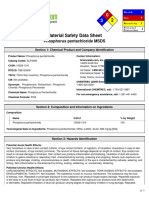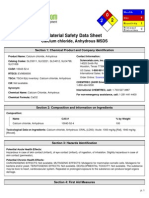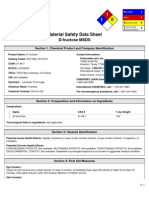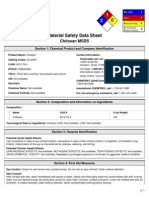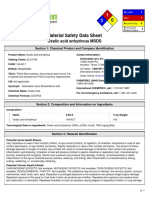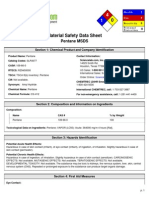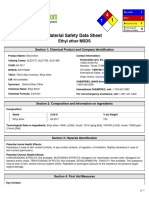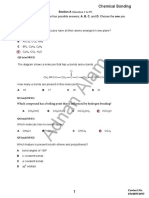Msds Dietil Eterijij
Msds Dietil Eterijij
Uploaded by
PriyosetyokoCopyright:
Available Formats
Msds Dietil Eterijij
Msds Dietil Eterijij
Uploaded by
PriyosetyokoOriginal Description:
Copyright
Available Formats
Share this document
Did you find this document useful?
Is this content inappropriate?
Copyright:
Available Formats
Msds Dietil Eterijij
Msds Dietil Eterijij
Uploaded by
PriyosetyokoCopyright:
Available Formats
4 1
Material Safety Data Sheet
Ethyl ether MSDS
Section 1: Chemical Product and Company Identification
Product Name: Ethyl ether Catalog Codes: SLE2170, SLE1783, SLE1465 CAS#: 60-29-7 RTECS: KI5775000 TSCA: TSCA 8(b) inventory: Ethyl ether CI#: Not available. Synonym: Diethyl Ether; Ether Chemical Name: Ethyl Ether Chemical Formula: C4H10O Contact Information: Sciencelab.com, Inc. 14025 Smith Rd. Houston, Texas 77396 US Sales: 1-800-901-7247 International Sales: 1-281-441-4400 Order Online: ScienceLab.com
He a lt h
2 4 0 H
Fire Re a c t iv it y P e rs o n a l P ro t e c t io n
CHEMTREC (24HR Emergency Telephone), call: 1-800-424-9300 International CHEMTREC, call: 1-703-527-3887 For non-emergency assistance, call: 1-281-441-4400
Section 2: Composition and Information on Ingredients
Composition: Name Ethyl ether CAS # 60-29-7 % by Weight 100
Toxicological Data on Ingredients: Ethyl ether: ORAL (LD50): Acute: 1215 mg/kg [Rat]. VAPOR (LC50): Acute: 73000 ppm 2 hours [Rat].
Section 3: Hazards Identification
Potential Acute Health Effects: Hazardous in case of skin contact (irritant), of eye contact (irritant), of ingestion, of inhalation. Slightly hazardous in case of skin contact (permeator). Potential Chronic Health Effects: CARCINOGENIC EFFECTS: Not available. MUTAGENIC EFFECTS: Mutagenic for mammalian somatic cells. Mutagenic for bacteria and/or yeast. TERATOGENIC EFFECTS: Not available. DEVELOPMENTAL TOXICITY: Not available. The substance may be toxic to skin, central nervous system (CNS). Repeated or prolonged exposure to the substance can produce target organs damage.
Section 4: First Aid Measures
Eye Contact: p. 1
Check for and remove any contact lenses. In case of contact, immediately flush eyes with plenty of water for at least 15 minutes. Cold water may be used. Get medical attention. Skin Contact: In case of contact, immediately flush skin with plenty of water. Cover the irritated skin with an emollient. Remove contaminated clothing and shoes. Cold water may be used.Wash clothing before reuse. Thoroughly clean shoes before reuse. Get medical attention. Serious Skin Contact: Wash with a disinfectant soap and cover the contaminated skin with an anti-bacterial cream. Seek immediate medical attention. Inhalation: If inhaled, remove to fresh air. If not breathing, give artificial respiration. If breathing is difficult, give oxygen. Get medical attention if symptoms appear. Serious Inhalation: Evacuate the victim to a safe area as soon as possible. Loosen tight clothing such as a collar, tie, belt or waistband. If breathing is difficult, administer oxygen. If the victim is not breathing, perform mouth-to-mouth resuscitation. Seek medical attention. Ingestion: Do NOT induce vomiting unless directed to do so by medical personnel. Never give anything by mouth to an unconscious person. If large quantities of this material are swallowed, call a physician immediately. Loosen tight clothing such as a collar, tie, belt or waistband. Serious Ingestion: Not available.
Section 5: Fire and Explosion Data
Flammability of the Product: Flammable. Auto-Ignition Temperature: 180C (356F) Flash Points: CLOSED CUP: -45C (-49F). Flammable Limits: LOWER: 1.9% UPPER: 36% Products of Combustion: These products are carbon oxides (CO, CO2). Fire Hazards in Presence of Various Substances: Extremely flammable in presence of open flames and sparks, of heat. Slightly flammable to flammable in presence of oxidizing materials, of acids. Explosion Hazards in Presence of Various Substances: Risks of explosion of the product in presence of mechanical impact: Not available. Highly explosive in presence of open flames and sparks, of heat. Slightly explosive in presence of oxidizing materials. Fire Fighting Media and Instructions: Flammable liquid, soluble or dispersed in water. SMALL FIRE: Use DRY chemical powder. LARGE FIRE: Use alcohol foam, water spray or fog. Cool containing vessels with water jet in order to prevent pressure build-up, autoignition or explosion. Special Remarks on Fire Hazards: Highly flammable. Will be easily ignited by heat, sparks, and flames. Vapors may travel to source of ignition and flash back. Most vapors are heavier than air. Burns with smokey greenish flame. Violent reaction or ignition on contact with halogens (e.g., bromine, chlorine), interhalogens (e.g., iodine heptafluoride), oxidants (e.g., silver perchlorate, nitrosyl perchlorate, nitryl perchlorate, chromyl chloride, fluorine nitrate, permanganic acid, nitric acid, hydrogen peroxide, peroxodisulfuric acid, iodine (VII) oxide, sodium peroxide, ozone, and liquid air), sulfur and sulfur compounds (e.g., sulfur when dried with peroxidized ether, sulfuryl chloride). Special Remarks on Explosion Hazards: Vapors may form explosive mixtures with air. Vapor explosion hazard indoors, outdoors, or in sewers. Run off to sewer may create a fire or explosion hazard. Containers may explode when heated. Tends to form explosive peroxides under influence of light and air and evaporated to dryness. Explosive reaction with boron triazide, bromine trifluoride, bromine pentafluoride, p. 2
perchloric acid, uranyl nitrate + light, wood pulp extracts + heat. Only electrical equipment of explosion proof type (group C classification) is permitted to be operated in ether areas. May explode when brought in contact with anhydrous nitric acid.
Section 6: Accidental Release Measures
Small Spill: Dilute with water and mop up, or absorb with an inert dry material and place in an appropriate waste disposal container. Large Spill: Flammable liquid. Keep away from heat. Keep away from sources of ignition. Stop leak if without risk. Absorb with DRY earth, sand or other non-combustible material. Do not touch spilled material. Prevent entry into sewers, basements or confined areas; dike if needed. Be careful that the product is not present at a concentration level above TLV. Check TLV on the MSDS and with local authorities.
Section 7: Handling and Storage
Precautions: Keep away from heat. Keep away from sources of ignition. Ground all equipment containing material. Do not ingest. Do not breathe gas/fumes/ vapor/spray. Wear suitable protective clothing. In case of insufficient ventilation, wear suitable respiratory equipment. If ingested, seek medical advice immediately and show the container or the label. Avoid contact with skin and eyes. Keep away from incompatibles such as oxidizing agents, acids, moisture. Storage: Store in a segregated and approved area. Keep container in a cool, well-ventilated area. Keep container tightly closed and sealed until ready for use. Avoid all possible sources of ignition (spark or flame). Do not store above 30C (86F). Hygroscopic; keep container tightly closed. Air Sensitive Sensitive to light.
Section 8: Exposure Controls/Personal Protection
Engineering Controls: Provide exhaust ventilation or other engineering controls to keep the airborne concentrations of vapors below their respective threshold limit value. Ensure that eyewash stations and safety showers are proximal to the work-station location. Personal Protection: Splash goggles. Lab coat. Vapor respirator. Be sure to use an approved/certified respirator or equivalent. Gloves. Personal Protection in Case of a Large Spill: Splash goggles. Full suit. Vapor respirator. Boots. Gloves. A self contained breathing apparatus should be used to avoid inhalation of the product. Suggested protective clothing might not be sufficient; consult a specialist BEFORE handling this product. Exposure Limits: TWA: 400 (ppm) from OSHA (PEL) [United States] TWA: 400 STEL: 500 CEIL: 500 (ppm) from ACGIH (TLV) [United States] TWA: 1200 STEL: 1520 CEIL: 1500 (mg/m3) from ACGIH (TLV) [United States] STEL: 500 (ppm) [Australia] TWA: 1200 (mg/ m3) from OSHA (PEL) [United States] Consult local authorities for acceptable exposure limits.
Section 9: Physical and Chemical Properties
Physical state and appearance: Liquid. (volatile, mobile liquid ) Odor: Sweetish. Pungent. Ethereal. Taste: Burning. Sweet. Molecular Weight: 74.12g/mole Color: Clear Colorless. p. 3
pH (1% soln/water): Not available. Boiling Point: 34.6C (94.3F) Melting Point: -116.3C (-177.3F) Critical Temperature: 192.7C (378.9F) Specific Gravity: 0.7134 (Water = 1) Vapor Pressure: 58.6 kPa (@ 20C) Vapor Density: 2.56 (Air = 1) Volatility: Not available. Odor Threshold: 0.83 ppm Water/Oil Dist. Coeff.: The product is more soluble in oil; log(oil/water) = 0.9 Ionicity (in Water): Not available. Dispersion Properties: See solubility in water, acetone. Solubility: Soluble in acetone. Partially soluble in cold water.
Section 10: Stability and Reactivity Data
Stability: The product is stable. Instability Temperature: Not available. Conditions of Instability: Heat, ignition sources, incompatible materials, light, air. Incompatibility with various substances: Highly reactive with oxidizing agents, acids. Corrosivity: Non-corrosive in presence of glass. Special Remarks on Reactivity: Air and light sensitive. Hygroscopic. Also incompatiable with bromoazide, chlorine, chlorine trifluoride, chromic anhydride, chromyl chloride, lithium aluminum hydride, nitrosyl perchlorate, nitryl perchlorate, ozone, perchloric acid, permanganated, sulfuric acid, potassium peroxide, sodium peroxide, triethyl aluminum trimethyl aluminum, bromine, iodine heptaflluoride, silver perchlorate, fluorine nitrate, permanganic acid, nitric acid, hydrogen peroxide, peroxodisulfuric acid, iodine (VII) oxide, peat soils, thiotriazyl perchlorate, sulfonyl chloride, sulfur, uranyl nitrate, acetyl peroxide, and wood pulp extracts. Can react vigorously with acetyl peroxide, air, bromoazide, ClF3, CrO3, Cr(OCl)2, LiAlH2, NOClO4, O2, NClO2, (H2SO4 + permanganates), K2O2, [(C2H5)3Al + air], [(CH3)3Al + air]. Special Remarks on Corrosivity: Not available. Polymerization: Will not occur.
Section 11: Toxicological Information
Routes of Entry: Absorbed through skin. Eye contact. Inhalation. Toxicity to Animals: WARNING: THE LC50 VALUES HEREUNDER ARE ESTIMATED ON THE BASIS OF A 4-HOUR EXPOSURE. Acute oral toxicity (LD50): 1215 mg/kg [Rat]. Acute toxicity of the vapor (LC50): 31000 0.5 hours [Mouse]. Chronic Effects on Humans: MUTAGENIC EFFECTS: Mutagenic for mammalian somatic cells. Mutagenic for bacteria and/or yeast. May cause damage to the following organs: skin, central nervous system (CNS). Other Toxic Effects on Humans: p. 4
Hazardous in case of skin contact (irritant), of ingestion, of inhalation. Slightly hazardous in case of skin contact (permeator). Special Remarks on Toxicity to Animals: LD50 [Rabbit] -Route: Skin; Dose: >20 ml/kg LDL[Man] - Route: Oral; Dose: 260 mg/kg Special Remarks on Chronic Effects on Humans: May affect genetic material (mutagenic) based on animal data. Special Remarks on other Toxic Effects on Humans: Acute Potential Health Effects: Skin: Causes skin irritation. It is not appreciably absorbed through intact skin. Eyes: Causes eye irritation. Can cause slight , reversible eye injury from contact with liquid or vapor. Inhalation: It is rapidly absorbed through lungs. Vapor mist causes irritation of the respiratory tract and mucous membranes. Affects behavior, sense organs, peripheral and central nervous systems, liver and metabolism, cardiovascular system. Symptoms may include excitement, drowsiness, headache, nausea, vomiting, paleness, decreased pulse and temperature, irregular respiration, coughing, bronchodilation, increase in respiratory rate, increase in heart rate, excessive salivation, muscle relaxation, anesthetic effects, and possible kidney irritation or injury, and temporarily abnormal liver function tests. Ingestion: May be harmful if swallowed. May cause gastrointestinal tract irritation with nausea, vomiting
Section 12: Ecological Information
Ecotoxicity: Not available. BOD5 and COD: Not available. Products of Biodegradation: Possibly hazardous short term degradation products are not likely. However, long term degradation products may arise. Toxicity of the Products of Biodegradation: The products of degradation are less toxic than the product itself. Special Remarks on the Products of Biodegradation: WHEN RELEASED INTO THE SOIL, THIS MATERIAL IS EXPECTED TO QUICKLY EVAPORAT WHEN RELEASED INTO THE SOIL, THIS MATERIAL IS EXPECTED TO LEACH INTO GROUNDWATER. WHEN RELEASED INTO THE SOIL, THIS MATERIAL IS NOT EXPECTED TO BIODEGRADE. WHEN RELEASED INTO WATER, THIS MATERIAL IS NOT EXPECTED TO BIODEGRADE. WHEN RELEASED INTO THE WATER, THIS MATERIAL IS EXPECTED TO HAV HALFLIFE OF LESS THAN 1 DAY. WHEN RELEASED TO WATER, THIS MATERIAL IS EXP TO QUICKLY EVAPORATE. THIS MATERIAL IS NOT EXPECTED TO SIGNIFICANTLY BIOACCUMULATE. THIS MATERIAL HAS A LOG OCTANOL-WATER PARTITION COEFFICIENT LESS THAN 3.0. WHEN RELEASED INTO THE AIR, THIS MATERIAL IS EXPECTED TO BE READILY DEGRADED BY REACTION WITH PHOTOCHEMICALLY PRODUCED HYDROXYL RADICA WHEN RELEASED INTO THE AIR, THIS MATERIAL IS NOT EXPECTED TO BE DEGRADED B PHOTOLYSIS. WHEN RELEASED INTO THE AIR, THIS MATERIAL IS EXPECTED TO HAVE HALF-LIFE BETWEEN 1 AND 10 DAYS.
Section 13: Disposal Considerations
Waste Disposal: Consult with Local and Regional (State) authorities (waste regulators). Waste must be disposed of in accordance with federal, state and local environmental control regulations.
Section 14: Transport Information
DOT Classification: CLASS 3: Flammable liquid. Identification: : Diethyl ether UNNA: 1155 PG: I Special Provisions for Transport: Not available.
Section 15: Other Regulatory Information
Federal and State Regulations: p. 5
Connecticut hazardous material survey.: Ethyl ether Illinois toxic substances disclosure to employee act: Ethyl ether Illinois chemical safety act: Ethyl ether New York release reporting list: Ethyl ether Rhode Island RTK hazardous substances: Ethyl ether Pennsylvania RTK: Ethyl ether Florida: Ethyl ether Minnesota: Ethyl ether Massachusetts RTK: Ethyl ether Massachusetts spill list: Ethyl ether New Jersey: Ethyl ether New Jersey toxic catastrophe prevention act: Ethyl ether Louisiana spill reporting: Ethyl ether California Director's List of Hazardous Substances: Ethyl ether TSCA 8(b) inventory: Ethyl ether TSCA 4(a) proposed test rules: Ethyl ether TSCA 8(a) PAIR: Ethyl ether Other Regulations: OSHA: Hazardous by definition of Hazard Communication Standard (29 CFR 1910.1200). EINECS: This product is on the European Inventory of Existing Commercial Chemical Substances. Other Classifications: WHMIS (Canada): CLASS B-2: Flammable liquid with a flash point lower than 37.8C (100F). DSCL (EEC): R12- Extremely flammable. R19- May form explosive peroxides. R22- Harmful if swallowed. S9- Keep container in a well-ventilated place. S16- Keep away from sources of ignition - No smoking. S29- Do not empty into drains. S33- Take precautionary measures against static discharges. HMIS (U.S.A.): Health Hazard: 2 Fire Hazard: 4 Reactivity: 0 Personal Protection: h National Fire Protection Association (U.S.A.): Health: 1 Flammability: 4 Reactivity: 1 Specific hazard: Protective Equipment: Gloves. Lab coat. Vapor respirator. Be sure to use an approved/certified respirator or equivalent. Wear appropriate respirator when ventilation is inadequate. Splash goggles.
Section 16: Other Information
References: Not available. Other Special Considerations: Not available. Created: 10/10/2005 08:18 PM Last Updated: 06/09/2012 12:00 PM The information above is believed to be accurate and represents the best information currently available to us. However, we make no warranty of merchantability or any other warranty, express or implied, with respect to such information, and we assume no liability resulting from its use. Users should make their own investigations to determine the suitability of the information for their particular purposes. In no event shall ScienceLab.com be liable for any claims, losses, or damages of any third party or for lost profits or any special, indirect, incidental, consequential or exemplary damages, howsoever arising, even if ScienceLab.com has been advised of the possibility of such damages.
p. 6
You might also like
- Potassium Chloride MSDS: Section 1: Chemical Product and Company IdentificationDocument5 pagesPotassium Chloride MSDS: Section 1: Chemical Product and Company IdentificationHarry PasaribuNo ratings yet
- Phosphorus Pentachloride MSDSDocument6 pagesPhosphorus Pentachloride MSDSashish24294No ratings yet
- MSDS ChloroformDocument7 pagesMSDS ChloroformYanAdhiPraNo ratings yet
- Msds BenzenaDocument8 pagesMsds BenzenaApriadiNo ratings yet
- MSDS Aluminum by SMTDocument6 pagesMSDS Aluminum by SMTSamadhanMachineToolsNo ratings yet
- Petroleum Development Oman L.L.C.: Document Title: Hydrogen Sulphide (H S) ManagementDocument22 pagesPetroleum Development Oman L.L.C.: Document Title: Hydrogen Sulphide (H S) ManagementSiva100% (1)
- Potassium Bromide MSDS: Section 1: Chemical Product and Company IdentificationDocument5 pagesPotassium Bromide MSDS: Section 1: Chemical Product and Company IdentificationFirda jihanNo ratings yet
- Mnso 4Document5 pagesMnso 4Muhammad AndrianNo ratings yet
- MsdsDocument5 pagesMsdssintiaNo ratings yet
- Cacl 2Document5 pagesCacl 2Ahmed Qomaruddin100% (1)
- Msds MurexideDocument5 pagesMsds MurexideD'the QuiintLy MaskatNo ratings yet
- Msds Na2so3Document6 pagesMsds Na2so3huythai2011No ratings yet
- Msds Heksana - 2 PDFDocument6 pagesMsds Heksana - 2 PDFrilmaNo ratings yet
- Msds KMnO4 - 2 PDFDocument6 pagesMsds KMnO4 - 2 PDFGregoriusNo ratings yet
- MSDS Vanadium PentoxideDocument5 pagesMSDS Vanadium PentoxideRezer AxelNo ratings yet
- Material Safety Data Sheet: Section 1 - Chemical Product and Company IdentificationDocument6 pagesMaterial Safety Data Sheet: Section 1 - Chemical Product and Company IdentificationRahasia Tahu RahasiaNo ratings yet
- Magnesium CarbonateDocument7 pagesMagnesium CarbonateAyi Wandhina Asa PratamaNo ratings yet
- 2 NaftolDocument5 pages2 Naftolhide999No ratings yet
- Alkohol 95%Document3 pagesAlkohol 95%putu mahendraNo ratings yet
- Whiting (CalciumCarbonate) MSDSDocument6 pagesWhiting (CalciumCarbonate) MSDSrinda_indaNo ratings yet
- Urea MsdsDocument5 pagesUrea MsdsVinnyVidichiNo ratings yet
- Acetophenon PDFDocument6 pagesAcetophenon PDFYuris Yurdiansah Munandar0% (1)
- MSDS NH4ClDocument2 pagesMSDS NH4Clember_memoriesNo ratings yet
- Msds Al2o3 PDFDocument6 pagesMsds Al2o3 PDFNazuah Ushwatun HassanahNo ratings yet
- Fructose MsdsDocument5 pagesFructose MsdsWalad WirawanNo ratings yet
- Calcium Chloride, Anhydrous MSDS: Section 1: Chemical Product and Company IdentificationDocument5 pagesCalcium Chloride, Anhydrous MSDS: Section 1: Chemical Product and Company IdentificationDarshilNo ratings yet
- Msds K2cr2o4Document6 pagesMsds K2cr2o4Dachi Diputro Niko100% (1)
- CCL4Document8 pagesCCL4Raditya Rizki AmaliaNo ratings yet
- Sulfanilamide MSDS: Section 1: Chemical Product and Company IdentificationDocument6 pagesSulfanilamide MSDS: Section 1: Chemical Product and Company IdentificationIsti YaniNo ratings yet
- Starch Soluble MsdsDocument5 pagesStarch Soluble Msdsshella168No ratings yet
- Zinc Oxide MSDSDocument6 pagesZinc Oxide MSDSMaryTanNo ratings yet
- Fehling ADocument5 pagesFehling AronaNo ratings yet
- 098 Potassium IodateDocument6 pages098 Potassium Iodateeng20072007No ratings yet
- NABH4 MsdsDocument6 pagesNABH4 Msdsm. mahmoudNo ratings yet
- Urea MSDS: Section 1: Chemical Product and Company IdentificationDocument5 pagesUrea MSDS: Section 1: Chemical Product and Company IdentificationFadli ApriantoNo ratings yet
- Msds GliserolDocument5 pagesMsds Gliserolalchemiy100% (1)
- VANILINDocument5 pagesVANILINlaila purnamaNo ratings yet
- Msds Buffer PH 10 BlueDocument5 pagesMsds Buffer PH 10 BlueMuhammad Irfan MalikNo ratings yet
- KIO3 MsdsDocument6 pagesKIO3 MsdsIgnacio Allende MenaNo ratings yet
- Msds Ammonia SolutionDocument9 pagesMsds Ammonia SolutionAmran HalimNo ratings yet
- MSDS Na2SO3Document6 pagesMSDS Na2SO3MunirohNo ratings yet
- Sun Cheng 2002Document11 pagesSun Cheng 2002ezequielarias01100% (1)
- Msds KitosanDocument5 pagesMsds KitosanNuky Dwifirly Pratiwi ArhathaNo ratings yet
- MSDS MaltosaDocument5 pagesMSDS MaltosaSatria Muliya PutraNo ratings yet
- Silica Plastic BlockDocument5 pagesSilica Plastic Blockdharshini deivasigamaniNo ratings yet
- 093 Potassium ChlorideDocument6 pages093 Potassium Chlorideeng20072007No ratings yet
- Msds (nh4) 2so4Document6 pagesMsds (nh4) 2so4rodhiatul jurdillah0% (1)
- KSCNDocument6 pagesKSCNRiza GhulamNo ratings yet
- Msds Boric AcidDocument6 pagesMsds Boric AcidmeitakurniatiNo ratings yet
- Albumin, Egg MSDS: Section 1: Chemical Product and Company IdentificationDocument5 pagesAlbumin, Egg MSDS: Section 1: Chemical Product and Company IdentificationSefin Nur AisyahNo ratings yet
- HCL 37 %Document7 pagesHCL 37 %Yohana MelianthaNo ratings yet
- Asam Oksalat (C2H2O4)Document6 pagesAsam Oksalat (C2H2O4)Dini HandayaniNo ratings yet
- Msds PDFDocument6 pagesMsds PDFToni ChandraNo ratings yet
- Msds N PentaneDocument6 pagesMsds N Pentanenirmal_subudhiNo ratings yet
- Msds Isoprop Alkohol PDFDocument6 pagesMsds Isoprop Alkohol PDFmbapioNo ratings yet
- Msds PentaneDocument6 pagesMsds PentaneMuhammad FikriansyahNo ratings yet
- (ch3) 2so4Document6 pages(ch3) 2so4arbol100100% (1)
- Ethyl Ether MSDS: Section 1: Chemical Product and Company IdentificationDocument6 pagesEthyl Ether MSDS: Section 1: Chemical Product and Company IdentificationAhmad SuhardimanNo ratings yet
- MsdsDocument6 pagesMsdsrashidalghifaryNo ratings yet
- MSDS - AnilinDocument6 pagesMSDS - AnilinsaririskihasibuanNo ratings yet
- Indikator PPDocument6 pagesIndikator PPNadhil Eka PutraNo ratings yet
- Structural Elucidation of Small Organic Molecules by 1d 2d and Multi Dimensional Solution NMR Spectroscopy 2155 9872.S11 001Document8 pagesStructural Elucidation of Small Organic Molecules by 1d 2d and Multi Dimensional Solution NMR Spectroscopy 2155 9872.S11 001PriyosetyokoNo ratings yet
- Air, Water and Land Pollution: Chromatographic Methods For Environmental AnalysisDocument90 pagesAir, Water and Land Pollution: Chromatographic Methods For Environmental AnalysisPriyosetyokoNo ratings yet
- Sodium Acetate MsdsDocument5 pagesSodium Acetate MsdsMehmet Besim SacilikNo ratings yet
- Bioorganic Synthesis - An Introduction (PDFDrive)Document453 pagesBioorganic Synthesis - An Introduction (PDFDrive)PriyosetyokoNo ratings yet
- Methanol Energy BalanceDocument6 pagesMethanol Energy BalancePriyosetyoko100% (2)
- Cement Production Basic Knowledge-ShangDocument21 pagesCement Production Basic Knowledge-Shangadrian3591No ratings yet
- Australian Journal of Chemistry (1975), 28 (10), 2227-54Document28 pagesAustralian Journal of Chemistry (1975), 28 (10), 2227-54rrgodboleNo ratings yet
- 634872894723912500Document107 pages634872894723912500Mahamudul HasanNo ratings yet
- Chapter 01 IntroductionDocument30 pagesChapter 01 IntroductionSurya Adhie100% (1)
- Experiment No. 1: Aim: To Identify The Cation and Anion in Copper Sulphate PentahydrateDocument3 pagesExperiment No. 1: Aim: To Identify The Cation and Anion in Copper Sulphate PentahydrateElite Gaming0% (1)
- Acabados Act 15.07.2022Document9 pagesAcabados Act 15.07.2022Frannklin NavarroNo ratings yet
- Chemical BondingDocument27 pagesChemical BondingDivyanshu YadavNo ratings yet
- Organometallic ChemistryDocument90 pagesOrganometallic Chemistrytharun thennarasuNo ratings yet
- Media Preparation and SterilizationDocument32 pagesMedia Preparation and SterilizationvitalesjulesmarkNo ratings yet
- Classification Test For Oraganic HalidesDocument3 pagesClassification Test For Oraganic HalidesRalph Timothy OngNo ratings yet
- Lipids - ReviewerDocument5 pagesLipids - ReviewerGabrielle FranciscoNo ratings yet
- 2023 - Selective Rubidium Recovery From Seawater With Metal-Organic Framework Incorporated Potassium Cobalt Hexacyanoferrate NanomaterialDocument12 pages2023 - Selective Rubidium Recovery From Seawater With Metal-Organic Framework Incorporated Potassium Cobalt Hexacyanoferrate NanomaterialJan LaurenceNo ratings yet
- Is 12308-4 - 1988 - 3Document1 pageIs 12308-4 - 1988 - 3Svapnesh ParikhNo ratings yet
- SPE112413 Guidon in Canterral Field PDFDocument15 pagesSPE112413 Guidon in Canterral Field PDFLeo Rojas DomNo ratings yet
- Solution TestDocument6 pagesSolution Testnahil ahmedNo ratings yet
- Paint - WikipediaDocument15 pagesPaint - Wikipediadeafrh4No ratings yet
- D - Chemical Bonding (1) SolvedDocument30 pagesD - Chemical Bonding (1) SolvedHayaa KhanNo ratings yet
- In Situ: Upgrading of Athabasca Tar Sand Bitumen Using ThaiDocument9 pagesIn Situ: Upgrading of Athabasca Tar Sand Bitumen Using ThaimohsenNo ratings yet
- Carbon and Its Compounds Class 10 Notes Science Chapter 4 Free PDFDocument28 pagesCarbon and Its Compounds Class 10 Notes Science Chapter 4 Free PDFShailendra KumarNo ratings yet
- Datasheet Sandvik 3r12 enDocument7 pagesDatasheet Sandvik 3r12 enAgustin CesanNo ratings yet
- 252 Galvanic Corrosion Compatibilty Chart Technical InformationDocument1 page252 Galvanic Corrosion Compatibilty Chart Technical InformationDan CosacNo ratings yet
- Biogas Generation A Study: By: Madhav Mohan Bsc. Physics (Hons.) Ii Year Roll Number: 1815052Document17 pagesBiogas Generation A Study: By: Madhav Mohan Bsc. Physics (Hons.) Ii Year Roll Number: 1815052Madhav Mohan100% (1)
- Perovskyt 5 ADocument18 pagesPerovskyt 5 ASegundo AcevedoNo ratings yet
- Spop 05Document4 pagesSpop 05Luiz FernandoNo ratings yet
- Shell CastingDocument24 pagesShell CastingMuhammad IshaqNo ratings yet
- Energy Consumption Calculation ToolDocument4 pagesEnergy Consumption Calculation Toolra4ul05100% (1)
- Water 15 00029Document22 pagesWater 15 00029Michel M.No ratings yet
- Hydrolub Us Eng 11 01Document2 pagesHydrolub Us Eng 11 01alexander villanuevaNo ratings yet
- MCGB - Data Sheet For Suppliers Old MAT Nos.: 282, - , - : Carbon Steel For Large ForgingsDocument3 pagesMCGB - Data Sheet For Suppliers Old MAT Nos.: 282, - , - : Carbon Steel For Large Forgingsbaskaran ayyapparajNo ratings yet

